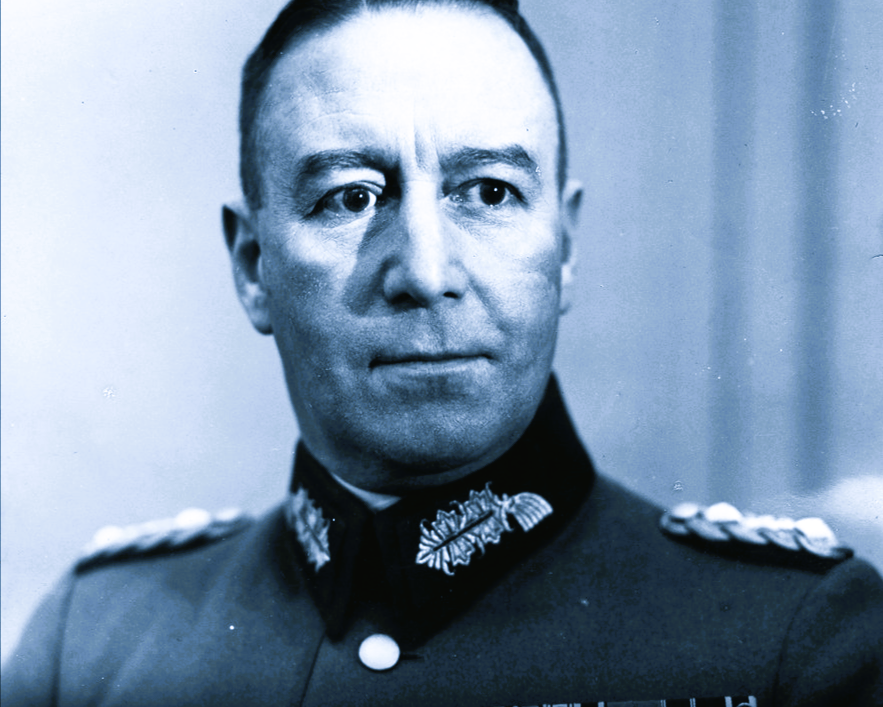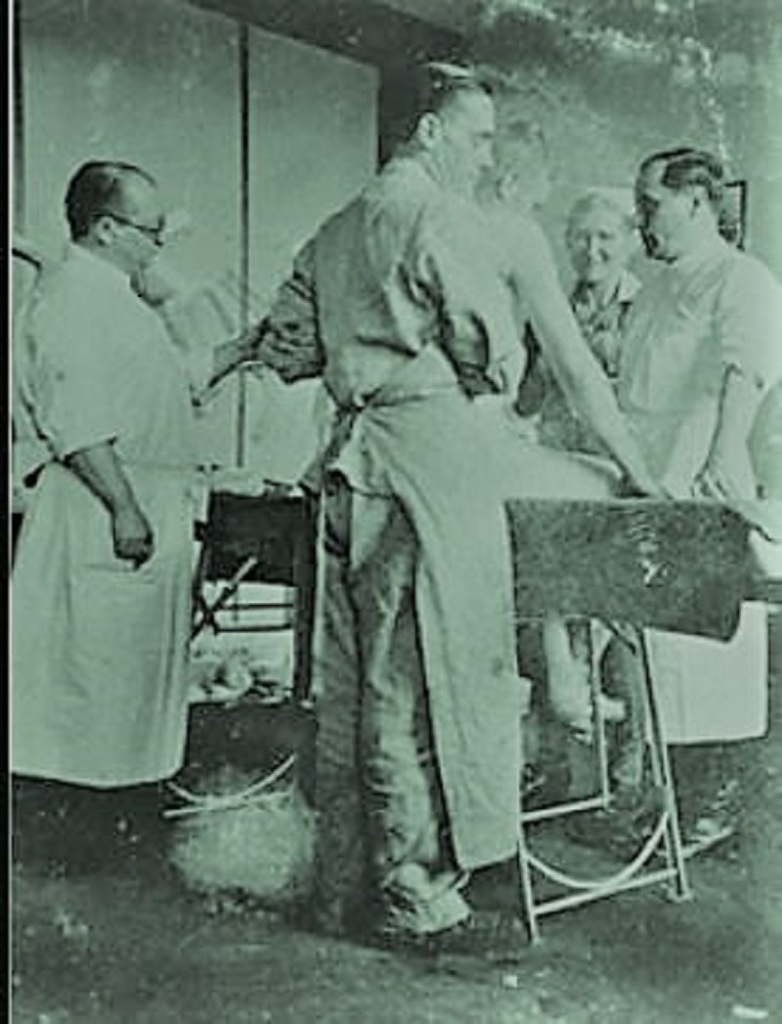
The one thing that really intrigues me about the Holocaust and other horrific events throughout history is, how people justify killing and torturing fellow human beings. It will take an awful lot before I would hurt another human being, only when I would be physically threatened would I resort to physical defence.
The Nazis didn’t see the Jews, Roma Sinti, disabled and homosexuals as human beings, they were referred to as sub-humans. But still, when someone of flesh and blood stands before you how can you not think that this is another human being?. Below are some excerpts from documents and speeches which may give an indication of the Nazi psyche and how they were able to convince ‘ordinary’ people to kill others.

On October 6, 1943, Heinrich Himmler, one of the most prominent figures in the Nazi regime, delivered a speech in front of SS officers in Posen, Poland. In this speech, he outlined the Nazi ideology regarding the extermination of the Jewish people. One of the chilling quotes from this speech is:
“I am now referring to the evacuation of the Jews, the extermination of the Jewish people. It’s one of those things that’s easily said: ‘The Jewish people are being exterminated,’ every party member will tell you, ‘perfectly clear, it’s part of our plans, we’re eliminating the Jews, exterminating them, a small matter.’ And then along they all come, all the 80 million upright Germans, and each one has his decent Jew. They say: all others are swine, but here is a first-class Jew.”
This quote encapsulates the horrifyingly casual manner in which Himmler and the Nazi leadership discussed and carried out the genocide of millions of Jewish people during the Holocaust. It reflects the dehumanization and systematic eradication of an entire population based on racial ideology.”

Joseph Goebbels, the Minister of Propaganda in Nazi Germany, kept extensive diaries from 1924 until he died in 1945. These diaries provide valuable insights into the mindset, strategies, and activities of the Nazi regime during its rise to power and throughout World War II.
Goebbels was known for his fervent loyalty to Adolf Hitler and his dedication to spreading Nazi propaganda through various media channels. His diaries reflect his unwavering commitment to the Nazi cause and his role in shaping public opinion in Germany.
“The Jews are alike. Whether they live in a ghetto of the East or in the bankers’ palaces of the City or Wall Street, they will always pursue the same aims and without previous agreement even use the same means. One might well ask why are there any Jews in the world order? That would be exactly like asking why are there potato bugs? Nature is dominated by the law of struggle. There will always be parasites who will spur this struggle on and intensify the process of selection between the strong and the weak. The principle of struggle dominates also in human life. One must merely know the laws of this struggle to be able to face it. The intellectual does not have the natural means of resisting the Jewish peril because his instincts have been badly blunted. Because of this fact the nations with a high standard of civilization are exposed to this peril first and foremost. In nature life always takes measures against parasites; in the life of nations that is not always the case. From this fact the Jewish peril actually stems. There is therefore no other recourse left for modern nations except to exterminate the Jew…”

Letter from Willy Just to SS-Obersturmbannführer Walter Rauff, 5 June 1942
“RE: Technical alterations to the special vehicles already in operation and those in production.
Since December 1941, for example, 97,000 have been processed using three vans without any faults developing in the vehicles. The well-known explosion in Kulmhof (Chelmno) must be treated as a special case. It was caused by faulty practice. Special instructions have been given to the relevant offices in order to avoid such accidents. The instructions were such as to ensure a considerable increase in the degree of security.
Further operational experience hitherto indicates that the following technical alterations are appropriate….
2) The vans are normally loaded with 9-10 people per square meter. With the large Saurer special vans this is not possible because although they do not become overloaded their maneuverability is much impaired. A reduction in the load area appears desirable. It can be achieved by reducing the size of the van by c. 1 meter. The difficulty referred to cannot be overcome by reducing the size of the load. For a reduction in the numbers will necessitate a longer period of operation because the free spaces will have to be filled with CO. By contrast, a smaller load area which is completely full requires a much shorter period of operation since there are no free spaces….
3) The connecting hoses between the exhaust and the van frequently rust through because they are corroded inside by the liquids which fall on them. To prevent this the connecting piece must be moved so that the gas is fed from the top downwards. This will prevent liquids flowing in….
6) The lighting must be better protected against damage than hitherto….It has been suggested that lighting should be dispensed with since they are allegedly never used. However, experience shows that when the rear door is closed and therefore when it becomes dark, the cargo presses hard towards the door….It makes it difficult to latch the door. Furthermore, it has been observed that the noise always begins when the doors are shut presumably because of fear brought on by the darkness.”

Letters to Adolf Rosenberg, sent by Hinrich Lohse and Wilhelm Kube
15 November 1941
Reichskommissar for Ostland
IIa 4
Secret
To: Reich Minister for the Occupied Eastern Territories
RE: Execution of Jews
To: Reich Minister for the Occupied Eastern Territories
RE: Execution of Jews
. . .Will you please inform me whether your inquiry of 31 October should be interpreted as a directive to liquidate all the Jews in Ostland? Is this to be done regardless of age, sex, and economic requirements (for instance, the Wehrmacht’s demand for skilled workers in the armament industry)? Of course, the cleansing of Ostland of Jews is a most important task; its solution, however, must be in accord with the requirements of war production.
Reichskommissar for Ostland(Hinrich Lohse.
December.1941
Reichskommissar for Ostland
To: Higher SS and Police Leader
. . . I request most emphatically that the liquidation of Jews employed as skilled workers in armament plants and repair workshops of the Wehrmacht who cannot be replaced at present by local personnel be prevented. . .
. . . Provision is to be made as quickly as possible for the training of suitable local personnel as skilled workers. . .
Lohse
Reichskommissar for Ostland
6.December.1941
Minsk
Generalkommissar for Byelorussia
To: Reichskommissar for Ostland
I wish to ask you personally for an official directive for the conduct of the civilian administration towards the Jews deported from Germany to Byelorussia. Among these Jews are men who fought at the Front and have the Iron Cross, First and Second Class, war invalids, half-Aryans, even three-quarter Aryans. . .
. . .These Jews will probably freeze or starve to death in the coming weeks.
. . On my own responsibility, I will not give the SD any instructions with regard to the treatment of these people. . .
I am certainly a hard [man] and willing to help solve the Jewish question, but people who come from our own cultural sphere just are not the same as the brutish hordes in this place. Is the slaughter to be carried out by the Lithuanians and Letts, who are themselves rejected by the population here? I couldn’t do it. I beg you to give clear directives [in this matter,] with due consideration for the good name of our Reich and our Party, in order that the necessary action can be taken in the most humane manner.
Heil Hitler!
Wilhelm Kube”

SS-Oberführer Viktor Brack was a key figure in the Nazi regime, particularly known for his involvement in the T-4 Euthanasia Program. This program aimed to exterminate individuals deemed physically or mentally disabled, as well as those considered genetically “unfit,” in the pursuit of Nazi racial hygiene ideology. Brack played a significant role in coordinating the logistics of the program, which involved the mass murder of hundreds of thousands of people through methods such as gas chambers and lethal injections.
Given Brack’s position and activities within the Nazi hierarchy, any correspondence attributed to him would likely pertain to matters related to the administration and execution of the T-4 Program or other initiatives associated with Nazi eugenics policies.
Letter from SS-Oberfuehrer Brack to Reichsfuehrer-SS Himmler, June23, 1942
“Honorable Mr. Reichsfuehrer!
According to my impression, there were at least 2-3 million men and women well fit for work among the approx. 10 million European Jews. In consideration of the exceptional difficulties posed for us by the question of labour, I am of the opinion that these 2-3 million should in any case be taken out and kept alive. Of course, this can only be done if they are in the same time rendered incapable of production. I reported to you about a year ago that persons under my instructions have completed the necessary experiments for this purpose. I wish to bring up these facts again. The type of sterilization which is normally carried out on persons with genetic disease is out of the question in this case, as it takes too much time and is expensive. Castration by means of X-rays, however, is not only relatively cheap but can be carried out on many thousands in a very short time. I believe that it has become unimportant at the present time whether those affected will then in the course of a few weeks or months realize by the effects that they are castrated.
In the event, Mr Reichsfuehrer, that you decide to choose these means—in the interest of maintaining labour material—Reichsleiter Bouhler will be ready to provide the doctors and other personnel needed to carry out this work. He also instructed me to inform you that I should then order the required equipment as quickly as possible.
——————————
Dear Brack,
It is only today that I have the opportunity to acknowledge the receipt of your letter of June 23. I am positively interested in seeing sterilization by X-rays tried out at least once in one camp in a series of experiments.
By order of Reichsleiter Bouhler, I submit to you as an enclosure a work of Dr. Horst Schumann on the influence of X-rays on human genital glands.”
(This blog was originally posted on June 18, 2016, titled, “How they justified the killings.”
Sources
https://www.hoover.org/research/curse-goebbels-diaries
https://www.bbc.com/news/world-europe-32363846
https://www.jewishvirtuallibrary.org/nazi-correspondence-regarding-gassing-vans
https://www.jewishvirtuallibrary.org/memoranda-to-himmler
http://www.camps.bbk.ac.uk/documents/073-racial-experiments.html

Donation
I am passionate about my site and I know you all like reading my blogs. I have been doing this at no cost and will continue to do so. All I ask is for a voluntary donation of $2, however if you are not in a position to do so I can fully understand, maybe next time then. Thank you. To donate click on the credit/debit card icon of the card you will use. If you want to donate more then $2 just add a higher number in the box left from the PayPal link. Many thanks.
$2.00


























You must be logged in to post a comment.